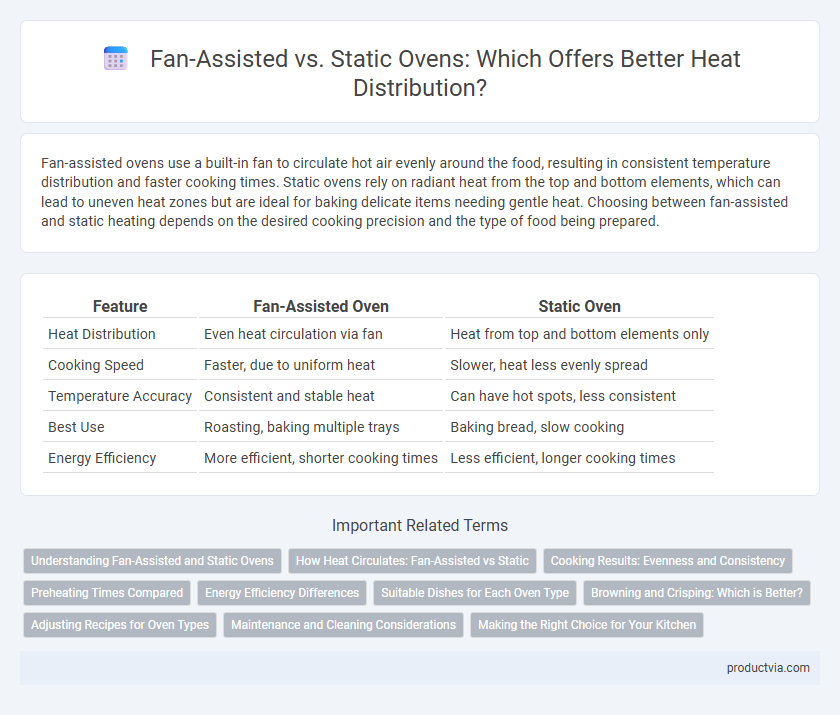Fan-assisted ovens use a built-in fan to circulate hot air evenly around the food, resulting in consistent temperature distribution and faster cooking times. Static ovens rely on radiant heat from the top and bottom elements, which can lead to uneven heat zones but are ideal for baking delicate items needing gentle heat. Choosing between fan-assisted and static heating depends on the desired cooking precision and the type of food being prepared.
Table of Comparison
| Feature | Fan-Assisted Oven | Static Oven |
|---|---|---|
| Heat Distribution | Even heat circulation via fan | Heat from top and bottom elements only |
| Cooking Speed | Faster, due to uniform heat | Slower, heat less evenly spread |
| Temperature Accuracy | Consistent and stable heat | Can have hot spots, less consistent |
| Best Use | Roasting, baking multiple trays | Baking bread, slow cooking |
| Energy Efficiency | More efficient, shorter cooking times | Less efficient, longer cooking times |
Understanding Fan-Assisted and Static Ovens
Fan-assisted ovens circulate hot air evenly throughout the cavity using an integrated fan and exhaust system, promoting uniform heat distribution and faster cooking times. Static ovens rely on natural heat rising from the bottom and top elements, resulting in uneven temperatures that are better suited for baking delicate items requiring gentle, consistent warmth. Understanding these differences enables users to choose the appropriate oven type based on cooking requirements, ensuring optimal results for roasting, baking, or grilling.
How Heat Circulates: Fan-Assisted vs Static
Fan-assisted ovens use a built-in fan to circulate hot air evenly around the food, promoting consistent heat distribution and faster cooking times. Static ovens rely on natural heat rising from the elements, resulting in uneven temperature zones that can cause hotspots or slower cooking. This fundamental difference in airflow significantly impacts cooking performance and the final texture of baked or roasted dishes.
Cooking Results: Evenness and Consistency
Fan-assisted ovens use a convection fan to circulate hot air, resulting in more even heat distribution and consistent cooking results across multiple shelves. Static ovens rely on natural heat radiation from the heating elements, which can create hot spots and uneven cooking, especially with baked goods. For recipes requiring uniform texture and color, such as cookies or roasts, fan-assisted cooking significantly improves overall evenness and reduces cooking time variability.
Preheating Times Compared
Fan-assisted ovens significantly reduce preheating times by circulating hot air evenly throughout the cavity, allowing the oven to reach the desired temperature faster than static ovens. Static ovens rely on radiant heat from the top and bottom elements without air circulation, resulting in slower temperature stabilization and longer preheating periods. Efficient heat distribution in fan-assisted ovens not only speeds up preheating but also promotes consistent cooking temperatures.
Energy Efficiency Differences
Fan-assisted ovens circulate hot air, promoting faster and more even heat distribution, which typically results in reduced cooking times and lower energy consumption compared to static ovens. Static ovens rely on radiant heat from the top and bottom elements, causing uneven temperature zones that may require longer cooking durations and increased energy use. Energy efficiency studies indicate fan-assisted models can save up to 20% more energy by maintaining consistent temperatures and speeding up the cooking process.
Suitable Dishes for Each Oven Type
Fan-assisted ovens excel at roasting meats and baking multiple trays of cookies due to their even heat distribution and faster cooking times. Static ovens are ideal for delicate dishes such as souffles, custards, and baked goods that require gentle, consistent heat without airflow. Choosing the right oven type enhances cooking precision and dish quality based on heat circulation needs.
Browning and Crisping: Which is Better?
Fan-assisted ovens circulate hot air evenly, promoting superior browning and crisping by removing moisture from the food's surface faster than static ovens. Static ovens rely on radiant heat from the top and bottom elements, which can result in uneven heat distribution and less consistent crisping. For optimal browning and crisping, fan-assisted ovens are generally preferred due to their enhanced airflow and temperature control.
Adjusting Recipes for Oven Types
Fan-assisted ovens use a convection fan to circulate hot air evenly, reducing cooking times and promoting uniform heat distribution, which often requires lowering the temperature by 20degC compared to static ovens. Static ovens rely on radiant heat from the top and bottom elements, resulting in slower and less even cooking, making it necessary to increase cooking durations and monitor food closely to avoid uneven baking or roasting. Adjusting recipes for fan-assisted ovens involves reducing temperature and cooking time, while static oven recipes should maintain original temperatures with extended cooking periods.
Maintenance and Cleaning Considerations
Fan-assisted ovens require regular cleaning of the fan and exhaust vents to prevent grease buildup and ensure optimal airflow, which can be more time-consuming than static ovens. Static ovens have fewer moving parts, making them easier to maintain and less prone to mechanical issues, resulting in simpler cleaning routines. Proper upkeep of fan-assisted models improves heat distribution efficiency, while static ovens benefit from straightforward maintenance but may experience uneven heat over time.
Making the Right Choice for Your Kitchen
Fan-assisted ovens use a built-in fan to circulate hot air evenly, resulting in faster and more uniform cooking ideal for baking multiple dishes simultaneously. Static ovens rely on radiant heat from top and bottom elements, providing gentle and traditional heat suitable for delicate recipes like souffles or slow roasting. Choosing between fan-assisted and static ovens depends on your cooking style, with fan-assisted models offering efficiency and even heat distribution while static ovens excel in precise, traditional heat application.
Fan-assisted vs Static for heat distribution Infographic

 productvia.com
productvia.com